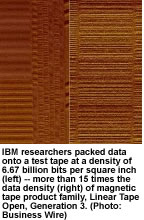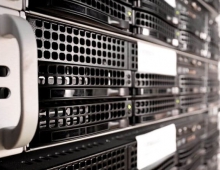
IBM Claims World Record in Magnetic Tape Data Density
IBM researchers today announced they have demonstrated a world record in data density on linear magnetic tape, showing that one of the computer industry's oldest and still most affordable data storage technologies has the potential to provide increased capacity for years to come.
The researchers at IBM's Almaden Research Center in San Jose, Calif., packed data onto a test tape at a density of 6.67 billion bits per square inch -- more than 15 times the data density of today's most popular industry standard magnetic tape products. To achieve this feat they created several new data-recording technologies and worked with Fuji Photo Film of Japan to develop a next-generation dual-coat magnetic tape capable of storing high-density data.
 The demonstration shows that magnetic tape data storage should be able to maintain its cost advantage over other technologies for years to come. When these new technologies and tape become available in products - projected to be in about five years - a cartridge the size of an industry-standard Linear Tape Open (LTO) tape cartridge could hold up to 8 trillion bytes (terabytes) of uncompressed data. This is 20 times the capacity of today's LTO-Generation 3 cartridge, which is about half the physical size of a VHS videocassette. Eight terabytes of data is equivalent to the text in 8 million books, which would require 57 miles of bookshelves.
The demonstration shows that magnetic tape data storage should be able to maintain its cost advantage over other technologies for years to come. When these new technologies and tape become available in products - projected to be in about five years - a cartridge the size of an industry-standard Linear Tape Open (LTO) tape cartridge could hold up to 8 trillion bytes (terabytes) of uncompressed data. This is 20 times the capacity of today's LTO-Generation 3 cartridge, which is about half the physical size of a VHS videocassette. Eight terabytes of data is equivalent to the text in 8 million books, which would require 57 miles of bookshelves.
Businesses use magnetic tape to store large volumes of important data that are used infrequently or don't require sub-second access times. These uses include data archives, backup files, replicas for disaster recovery and retention of information required for regulatory compliance. Such data are often contained within automated tape libraries where one or more read-write units service dozens to thousands of tape cartridges. High-end tape libraries can thus store petabytes - millions of gigabytes - of information. On a per-gigabyte basis, tape systems are currently about one-fifth to one-tenth the cost of today's hard-disk-drive storage systems, depending on their size. Moreover, tape cartridges consume no energy unless they are being accessed - unlike spinning disks, which need occasional use to remain operational - providing another area of potential cost savings.
The Almaden researchers also developed technologies to improve the capabilities of read-write heads and the methods for positioning the heads and handling the tape to enable data tracks one-tenth as wide as in current products. Scientists from IBM's Zurich Research Laboratory developed a new coding method that improved the accuracy of reading the tiny magnetic bits.
"This is a major milestone in our program and gives magnetic tape the density boost that we gave hard-disk drives in the 1990s," said Spike Narayan, senior manager of advanced technology concepts at IBM Almaden.
The demonstration was performed at product-level tape speeds (4 meters per second) and achieved error rates that should be correctable, using advanced error-correction techniques, to meet IBM's specification for its LTO-3 products.
 The demonstration shows that magnetic tape data storage should be able to maintain its cost advantage over other technologies for years to come. When these new technologies and tape become available in products - projected to be in about five years - a cartridge the size of an industry-standard Linear Tape Open (LTO) tape cartridge could hold up to 8 trillion bytes (terabytes) of uncompressed data. This is 20 times the capacity of today's LTO-Generation 3 cartridge, which is about half the physical size of a VHS videocassette. Eight terabytes of data is equivalent to the text in 8 million books, which would require 57 miles of bookshelves.
The demonstration shows that magnetic tape data storage should be able to maintain its cost advantage over other technologies for years to come. When these new technologies and tape become available in products - projected to be in about five years - a cartridge the size of an industry-standard Linear Tape Open (LTO) tape cartridge could hold up to 8 trillion bytes (terabytes) of uncompressed data. This is 20 times the capacity of today's LTO-Generation 3 cartridge, which is about half the physical size of a VHS videocassette. Eight terabytes of data is equivalent to the text in 8 million books, which would require 57 miles of bookshelves.
Businesses use magnetic tape to store large volumes of important data that are used infrequently or don't require sub-second access times. These uses include data archives, backup files, replicas for disaster recovery and retention of information required for regulatory compliance. Such data are often contained within automated tape libraries where one or more read-write units service dozens to thousands of tape cartridges. High-end tape libraries can thus store petabytes - millions of gigabytes - of information. On a per-gigabyte basis, tape systems are currently about one-fifth to one-tenth the cost of today's hard-disk-drive storage systems, depending on their size. Moreover, tape cartridges consume no energy unless they are being accessed - unlike spinning disks, which need occasional use to remain operational - providing another area of potential cost savings.
The Almaden researchers also developed technologies to improve the capabilities of read-write heads and the methods for positioning the heads and handling the tape to enable data tracks one-tenth as wide as in current products. Scientists from IBM's Zurich Research Laboratory developed a new coding method that improved the accuracy of reading the tiny magnetic bits.
"This is a major milestone in our program and gives magnetic tape the density boost that we gave hard-disk drives in the 1990s," said Spike Narayan, senior manager of advanced technology concepts at IBM Almaden.
The demonstration was performed at product-level tape speeds (4 meters per second) and achieved error rates that should be correctable, using advanced error-correction techniques, to meet IBM's specification for its LTO-3 products.





















